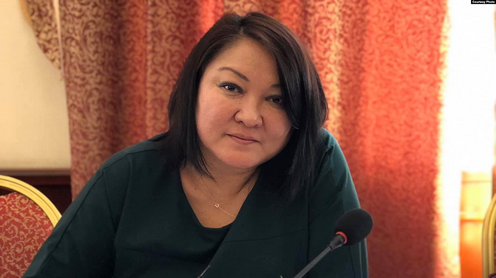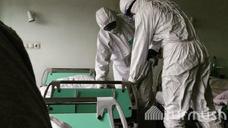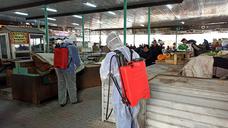For the first few months of the coronavirus pandemic, Central Asian countries appeared to be doing well. Borders were swiftly closed in the middle of March, when the first imported cases in the region were detected. Sweeping quarantine regulations were quickly introduced and extensive lockdowns put in place – at least in Kazakhstan, Kyrgyzstan and Uzbekistan. By the start of June, Kazakhstan had reported just 41 deaths, Uzbekistan 15 and Kyrgyzstan fewer than 10. Tajikistan, which after weeks of speculation acknowledged its first 47 deaths within a month of the arrival of a WHO mission at the start of May (and has since reported only 14 more) and Turkmenistan, which, then as now, denies any cases of COVID-19 (and now attributes its recent lockdown to unspecified “harmful dust” amid reports of a major wave of pneumonia cases), were on their own, variously credible trajectories.
Of course, one could suspect that limited testing, particularly in Tajikistan, had left not a small number of infections and deaths outside of the official statistics. At the very least, however, swift action had combined with varying degrees of isolation to prevent the kind of surge in infections that it was originally feared would easily overwhelm the region’s fragile healthcare systems. The level of testing in Kazakhstan, moreover, was comparable to many better-equipped nations, and in mid-May WHO European regional office head Hans Kluge praised Kazakhstan for its successes in fighting COVID-19. Governments all over the region were patting themselves on the back.
At about the same time as Kluge tweeted his praise, and under mounting economic pressure, Kazakhstan, Kyrgyzstan and Uzbekistan began to gradually lift their lockdowns, the latter a little more cautiously than its neighbours. Within six weeks the situation changed dramatically – at least in Kazakhstan and Kyrgyzstan. Reports came in of overfull hospitals having to turn patients away, of emergency services being unable to keep up with demand, of large numbers of people dying in their homes or even right outside of hospital entrances. Strangely, many of the severely sick and dying tested negative for COVID-19, resulting in a short-lived global media flurry over a lethal “unknown pneumonia” in Kazakhstan. The situation seemed to repeat itself, albeit in more muted fashion, in Uzbekistan towards the end of July.
In each case, after a lag, the state – and civil society – did manage to respond. Emergency services capacity was expanded and temporary day hospitals were set up to take the pressure off of permanent facilities. Governments laid most of the blame at the feet of their “careless” populations, lulled into a false sense of security by central state successes. Others asked instead why public authorities had not prepared better during the time they won with their lockdowns.
From many stories on social media, however, the picture that emerges is not just one of ill-prepared healthcare systems struggling to cope with a sudden surge in demand, but of a level of disorganisation and chaos that sometimes beggars belief. People were unable to get an ambulance for dying loved ones for days at a time; hospitals that were not always entirely full refused to admit people unless they had a positive coronavirus test result, yet people were often waiting for up to a week to get their results. The emergency services too often refused to respond to callouts for those who had negative test results, despite mounting evidence of massive false negatives. It became abundantly clear that, even taking into account the constraints on capacity, staff and equipment, what help there was available was not being given to the right people at the right time.
What exactly happened during these “terrible days”? One of the best explanations was provided in a recent interview that RFE/RL’s Kazakh service Azattyq conducted (in Russian) with Bermet Baryktabasova, a Kyrgyz expert on evidence-based medicine and clinical standards specialist. We translate an abridged version of the interview here with permission from RFE/RL. As Baryktabasova tells it, an excessive focus on faulty PCR tests combined with low capacity and poor planning to cause a breakdown in hospitalisation and treatment routines that had immensely tragic consequences.
“Asymptomatic patients were hospitalised, while seriously ill patients were dying in their homes”
Asked first of all by Azattyq to comment on the different approaches taken by the Kyrgyz and Kazakh health authorities to unify their COVID-19 and pneumonia statistics, Bermet Baryktabasova said the following: “Let’s begin by talking about why this statistical ‘fork’ arose to start with. At the beginning of the pandemic, the World Health Organisation added the code U07.1 to the ICD-10 (International Classification of Diseases, 10th Revision). U07.1 is confirmed coronavirus, identified by PCR diagnostics even in the absence of symptoms and other signs. Alongside it came unconfirmed coronavirus – U07.2. In other words, if there is a clinical picture (of the disease), but the PCR test is negative, this is considered to be unconfirmed COVID-19. The WHO explained that if there are signs of community-acquired pneumonia then it is possible to add its code – J18 – too.
“The decision was taken to go by PCR diagnostics, but no one asked about the fact that how accurate this technique is depends on errors committed during testing, and on whether swabs are collected correctly. It was assumed that in all countries the test kits would be good quality and testing would be carried out to a high standard. An ideal situation was envisaged. But this happened only in Southeast Asia: Singapore, Hong Kong, South Korea, Japan. They had already-devised methods, skilled lab workers, high-tech laboratories and mass testing. In countries like Kyrgyzstan, all these potential errors were not taken into account, and they reached as high as 80%. We got both false positives and false negatives.
“Relying only on PCR tests was very rash. In doing so, the WHO severely restricted the use of other diagnostic methods for confirming COVID-19. As a result, the whole world started to look only to the tests. This goes against the dictates of classical medicine: no attention was paid to patients’ complaints, anamnesis, clinical symptoms, information from scans and morphological indicators.
“Thus it was that unconfirmed coronavirus cases started to be coded as community-acquired pneumonia. Besides this, according to the recommendations of the WHO, if a PCR test came back positive then a patient had to be hospitalised, regardless of the level of severity. A small number of patients ended up in hospital, while those who were truly ill, but got a negative test result, were left to fend for themselves. They were given the diagnosis “community-acquired pneumonia”. About 80% of the patients in our hospitals were asymptomatic, while severely ill patients were dying in their homes.
“This is not to mention all the cases that were hidden under strokes, diabetes, heart attacks. It was only at a later stage that we understood that COVID-19 can lead to septic shock and multiple organ failure. Now it is absolutely clear that it is not just the lungs that suffer. (...) We underestimated just how dangerous an adversary the coronavirus is, and for this reason a huge number of cases were diagnosed as other illnesses and conditions.”
In response to Azattyq’s question about what exactly the term “community-acquired pneumonia” means, Bermet Baryktabasova explained that it simply refers to pneumonia cases where the infection occurred outside of hospital, before continuing: “The cause can be various different infectious agents: both bacteria and viruses. But they generally do not cause this level of mortalities. Dying of staphylococcal pneumonia in the 21st century is simply nonsense.
“There are very clear guidelines for treatment. All these years, pneumonia has been treated at home by antibiotics in tablet form. It would never occur to anyone to hospitalise such patients. Because the PCR tests were negative, a mass of COVID diagnoses started to be hidden under community-acquired pneumonia. The ‘fork’ grew bigger and bigger. It was clear not just to doctors, but to everyone, that people were dying in exactly the same way, it was just that some of them had positive PCR test results and others didn’t.
“The first group were hospitalised and paid compensation. But those with negative PCR tests couldn’t even get an ambulance to come and pick them up, and they were not included among COVID fatalities. Post mortems were only conducted on people who were positive. Say, for example, 53 bodies came in one night – three were positive and 50 negative. Post mortems would be conducted on those three as instructed, with all the necessary safety measures, and the bodies would not be given to the families but instead quickly buried. But the fifty others were not given a post mortem and were handed straight over.”
“Medics demanded the government be honest with the public”
To Azattyq’s question of what it was that brought about the transition to a new method of counting, Baryktabasova said the following: “This transition was inevitable, everything was so obvious. I don’t know why this didn’t cause the masks to fall in Kazakhstan and force people to give up on all the formalities and pretence. In Kyrgyzstan the authorities didn’t have any choice. They realised that it would simply be unacceptable to say to thousands of people: ‘You have some kind of pneumonia’. At the start, of course, this was exactly what happened. They said: ‘He had some kind of pneumonia, that’s what he died from’. COVID-19 was put on one side: the pandemic that we’re fighting, with all the resources, all the critical measures. And then these people have ‘some kind of different’ pneumonia, which at that moment started to appear in numbers ten times greater than those with positive tests – 600 people died of it while those who died with positive PCR tests were many times fewer.
“Medics demanded that the government be honest with the public. What was going on was straightforward discrimination: hospitals were not admitting the ‘negatives’ and people were dying right outside the entrance. Doctors were ordered to say: ‘We need a positive PCR test’. Never before has medical assistance been denied in such a way. Ambulance services never asked: ‘Do you have the results of a PCR analysis or a scan?’ Basic principles were violated to such an extent that our government was faced with no choice. People were dying: lots of people, suddenly, painfully. It stopped being a question of statistics. An objective reality presented itself which showed that the whole statistics were, maybe not disgrace, but a distortion.
“We in the healthcare sector made an important public statement, we said: ‘Stop tormenting us, all medical workers are working by double standards. They know very well that this is one and the same infection, but they are being forced to refuse people treatment purely on the basis of someone’s orders, inaccurate protocols and tests that have a huge rate of error.’ We were very angry at the WHO for not anticipating such a situation. We followed its recommendations and we fell into this trap.”
Asked why it was precisely Kazakhstan and Kyrgyzstan that fell into this trap, Baryktabasova answered: “It’s a very strange situation. I’m sure that studies will be carried out, research will be done into the epidemiological circumstances. For all of us, this is an entirely new situation. In comparison to the Italian and American scenarios, things looked to be more or less okay here. We knew that COVID-19 was spreading. But in the first few months this did not happen along the lines of the Italian scenario or the Wuhan scenario. It couldn’t even really be called an epidemic at all. Just 10 deaths over a period of four months. And the public stopped believing (that it was a problem) and started to say: ‘33,000 patients die here each year, that’s three or four thousand a month. Yet we are peering at these 10 cases through a microscope. Stop messing us around.’ But what happened to us after this was a tragedy. It came suddenly, instantly – what normally gets spread out over half a year or a year happened here in a week. Thousands of people suddenly fell seriously ill and needed intensive care and oxygen.”
“The so-and-sos have shamed the country”
Azattyq’s journalist then said the following: “In Kazakhstan it is felt that the statistics are being deliberately manipulated. For example, they decided to count pneumonia cases after an international scandal erupted due to Chinese announcements about a ‘lethal Kazakh pneumonia’. But then it emerged that they only planned to include cases confirmed from 1 August onwards. There are different explanations circulating among the public about why this is being done: they don’t want to frighten the public, ‘it will look bad’ in the eyes of the international community... Some think that the authorities are doing it to avoid paying compensation to sick medical workers or the families of medics who die. Because, of course, if the authorities do not acknowledge that they died from COVID-19 then they are technically not entitled to compensation...”
“I am just expressing my own personal opinion here and I cannot claim to reflect the whole objective reality, but I don’t think that all this started with the COVID-19 pandemic,” Bermet Baryktabasova said in reply. “There are historical precedents. This relationship to statistics is an inheritance from our shared Soviet past, when we had the Iron Curtain, true mortality figures were concealed and there were many things about which it was not possible to speak.
“The WHO should have set out universal criteria, so that COVID-19 deaths around the world were diagnosed clearly from the very start. But this didn’t happen. It ended up being so that the Italians, for instance, counted everyone. They didn’t look to see if someone had third or fourth stage cancer or how much of the body was afflicted. If there was a positive COVID-19 test then they put this as the cause of death. The USA had its own way of counting. Russia also did things its own way: they counted according to PCR tests and to this day they still haven’t unified their statistics – though even without this they are in the top five in terms of mortality. If they do unite their statistics then I’m sure the numbers will be huge.
“When Kyrgyzstan unified its statistics and quickly shot up into the top positions in terms of deaths, people here got angry: ‘The so-and-sos have shamed the country’.
“In my view, Kyrgyzstan did the right thing by stopping playing games with the public and with the data. My opinion as a doctor is that we should be honest with the public. Who are we trying to fool? We are doing all this for our own benefit, after all. It is based on the statistics that funding and resources and distributed, and decisions are taken on diagnostics and hospitalisation.”
Azattyq then asked how Kyrgyzstan was able to unify its statistics so fast when Kazakhstan’s health ministry had announced that unification would only happen on 1 August, since it was a very complex technical task – and that none of the country’s 234,000 pneumonia cases from January up until then would be included as it is very difficult to isolate from among the mass of cases exactly which ones were COVID-19. The ministry also referred to the fact that the WHO has recommended coding according to new codes in the ICD-10.
Dismissing all of these claims as “excuses”, Baryktabasova said that the Kyrgyz authorities had also dallied for around a month, but that Kyrgyz doctors had insisted. “I don’t know what IT guys they had to hire to do this, but they did it. I don’t think it happened fast, but in comparison to Kazakhstan it was fast. And you (Kazakhs) have the resources and the technical capabilities. It’s easy to count. We didn’t have any catastrophic nor even significant level of mortalities this year from influenza or from community-acquired pneumonia among adults. And then there was a flurry suddenly in the summer.”
Doctors had insisted she said, partly out of a desire for justice for their colleagues. “Around a hundred healthcare workers have already died, because they carried on doing their jobs. Now we’re demanding that the deaths of all those who have died while doing their duty are recognised and compensation is paid. Paramedics, nurses passed away in silence. They mustn’t be forgotten,” Baryktabasova said.
Pressed on the issue of how easy it is to isolate exactly which previous cases were coronavirus pneumonia, the medical expert said that doctors keep a record of all kinds of indicators other than tests: anamnesis, clinical diagnosis, scans, autopsy results. “I have no doubt that our Kazakh colleagues too made a note of this (coronavirus pneumonia), wrote – I don’t know how directly – something like ‘with Covid characteristics’. But for doctors all this was obvious. It simply can’t happen that people come in with identical symptoms and one person with a positive PCR test result dies from COVID-19 and another with a negative test result from something different.”
On the question of how Kyrgyzstan is doing now, Baryktabasova said: “Things are calming down. The peak has passed, when 80 people were dying a day and up to a thousand new infections were being detected. All of them were trying to secure a hospital bed. The ambulance services didn’t have time to respond to the calls. The authorities frantically started to open up new wards, new points of treatment. But a large number of people ended up without oxygen, without access to intensive care and medical staff. Then they started to open day hospitals, so that people could at least get some outpatient treatment.
“Volunteers had a massive impact. The medical community appealed to the public, saying that doctors and nurses are working themselves into the ground and that they need help with medication supplies and oxygen concentrators. And the public and businessmen responded. Somehow everyone just spontaneously came together. The government too appealed to the public. And people responded. At one time they were saving hundreds of people’s lives each night: some through donated medication, others by bringing them in to hospital.”
Azattyq then asked if there was a shortage of medication in Kyrgyzstan too, since in Kazakhstan there was a “huge crisis” in this area. Baryktabasova replied: “The situation here was similar. Of course, the fact that they were private companies played a role. Prices were inflated: drugs were out of people’s reach both physically and economically. A lot of people got rich during these terrible days. A lot of Kyrgyz live abroad in various countries and started sending medication home from these places: Germany, Russia, the USA, Canada. This really saved us.
“I don’t know how far the deaths that did occur were preventable, but the lion’s share of cases where people did receive the necessary care were made possible by the fact that the public stood up and started to help itself. To the extent that it was able, the government provided equipment by the end of these three to four weeks. Purchases were made, tenders arranged, medication procured, but only a couple of weeks after the start. It came too late.”
In its final question, Azattyq asked Bermet Baryktabasova if she was satisfied with Kyrgyzstan’s current statistics and what she could say about the figures in other Central Asian countries. The medical specialist replied: “The statistics only reflect what we see. They also reflect what people want to hide, for various reasons: in order to avoid spreading panic, or to avoid paying compensation – you’re familiar with all this. But reality is stubborn. Kyrgyzstan is a small country, everyone knows when a family suffers the loss of a loved one, who the doctor was, who was at home and got infected somehow there and who went to work, got sick there and died.
“I am against hiding statistics for any reason, however great the fear of ‘bringing shame’ on the country. It is not shameful to admit one’s mistakes. Experts have a huge amount of work ahead of them, it would be good if the data was not hidden from them. None of this is done for the sake of the statistics. When we unified the data, it made everyone’s job easier. People stopped getting frustrated: ‘How can you say three people died yesterday? We were bringing them in one after the other. There were definitely far more than this.’ But you can’t please everyone. Now the other half of the population is saying: ‘Now you’ve brought shame on us all’. But this is not shameful, it is honourable. It looked strange when tiny Kyrgyzstan with its lack of resources was reporting only a minuscule number of fatalities. Now we have more deaths than even Tajikistan, because they are keeping silent, and we are telling things as they are.”
-
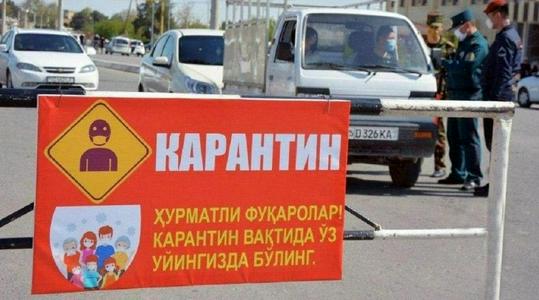 31 July31.07“Another week and I wouldn’t have got out of there alive”Why patients in Uzbekistan fear ending up in hospital, and medics fear the end of the lockdown
31 July31.07“Another week and I wouldn’t have got out of there alive”Why patients in Uzbekistan fear ending up in hospital, and medics fear the end of the lockdown -
 21 July21.07War of worldsThe first public protest action in Uzbekistan in defence of women’s rights met with an aggressive reaction from much of society
21 July21.07War of worldsThe first public protest action in Uzbekistan in defence of women’s rights met with an aggressive reaction from much of society -
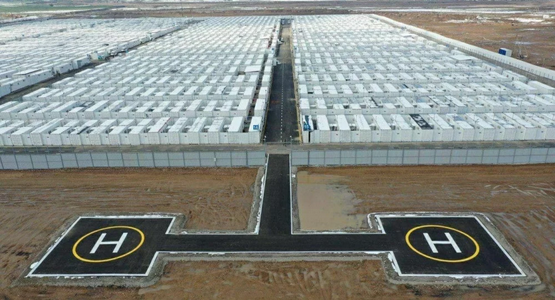 08 June08.06A very literal containmentHow Central Asia fought the coronavirus with quarantines, Part 2: Uzbekistan’s container camps
08 June08.06A very literal containmentHow Central Asia fought the coronavirus with quarantines, Part 2: Uzbekistan’s container camps -
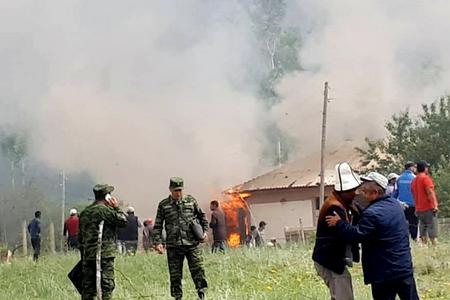 02 June02.06ВидеоFire and stone hailViolent clashes break out on the Uzbek-Kyrgyz border
02 June02.06ВидеоFire and stone hailViolent clashes break out on the Uzbek-Kyrgyz border -
 19 May19.05“I felt like a criminal”How Central Asia fought the coronavirus with quarantines – and appears to be winning
19 May19.05“I felt like a criminal”How Central Asia fought the coronavirus with quarantines – and appears to be winning -
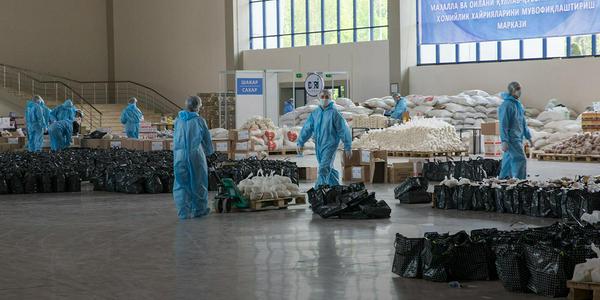 26 April26.04“Generosity and Assistance”The Uzbek government has announced plans to help the public through the coronavirus crisis – with the main role falling to private business
26 April26.04“Generosity and Assistance”The Uzbek government has announced plans to help the public through the coronavirus crisis – with the main role falling to private business

